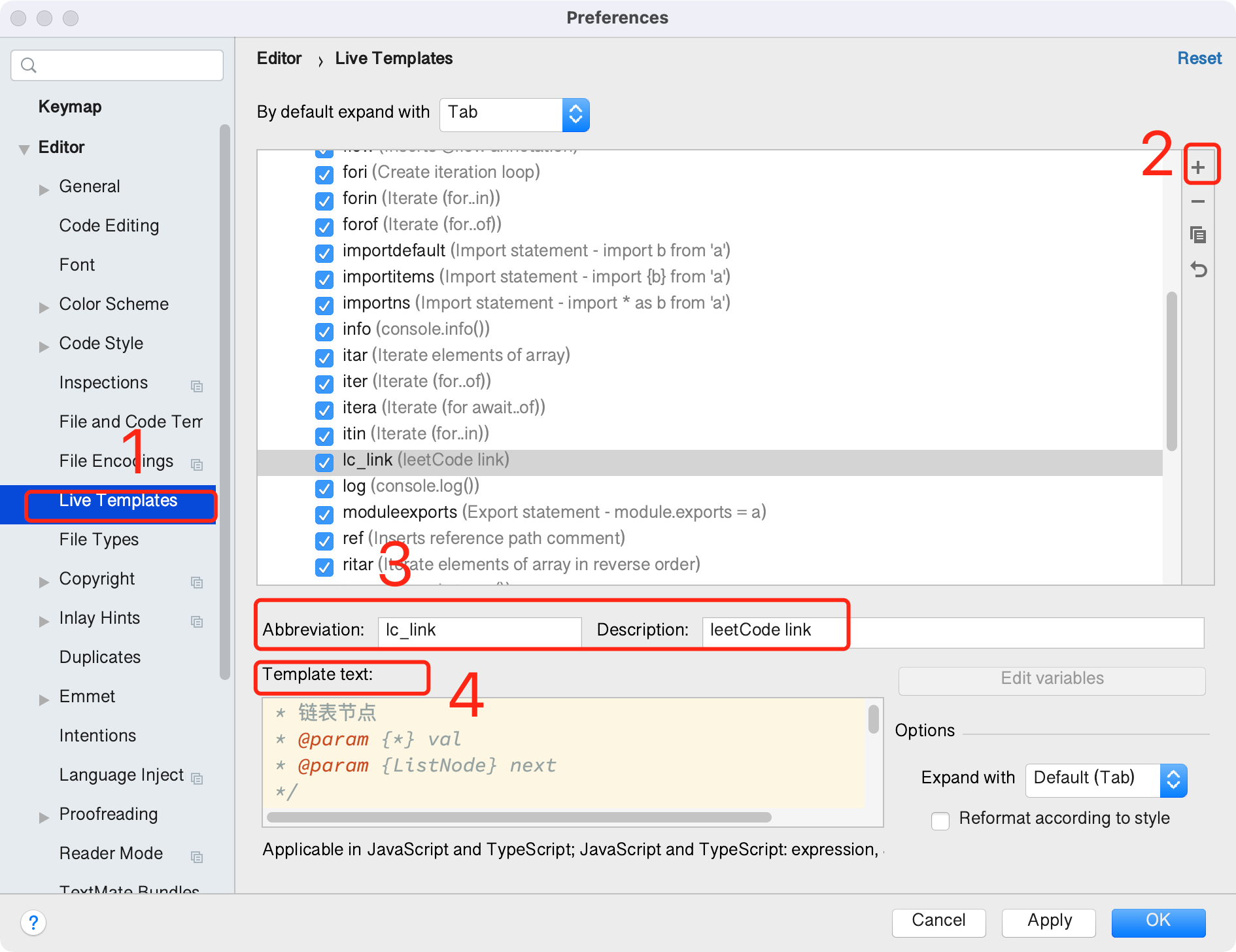刚开始刷LeetCode上链表相关的题目,在此记录下,本文主要包括:添加js链表代码模版-webstorm代码模版(这样刷题就不用每次都重新写了),头插法、尾插法、递归合并两个有序链表。
一、添加js链表代码模版
将下面的代码复制,然后打开webstorm设置,然后如下图中1 2 3 4,按顺序点击2中加号后,点击Live Templates,然后3中是自定的模版名字,复制代码模版到4中,然后点击应用后在webstorm里打出自定的模版名字就可以使用。

function ListNode(val, next = null) {
this.val = val;
this.next = next;
}
const getListFromArray = (array) => {
let dummy = new ListNode()
let pre = dummy;
array.forEach(x => pre = pre.next = new ListNode(x));
return dummy.next;
}
const logList = (list) => {
let str = 'list: ';
while (list) {
str += list.val + '->';
list = list.next;
}
str += 'null';
console.log(str);
}
|
二、头插法
使用头插法建立单链表,头插法是将一个新结点插入到链表的头节点之后,链表中元素顺序和读入数据的顺序相反,也可以用于链表逆序。
合并两个有序链表,本问题的实现中分为以下几种情况,l1和l2均为空,l1 l2至少一个不为空(分三种,全不为空,l1空,l2空)
l1 = [1, 2, 4];
l2 = [1, 3, 4];
l1 = getListFromArray(l1)
l2 = getListFromArray(l2)
logList(mergeTwoLists(l1,l2))
function mergeTwoLists(l1, l2) {
if (!l1 && !l2) {
return l1;
}
let head = new ListNode(null);
while (l1 || l2) {
let s;
while (l1 && l2 && l1.val <= l2.val) {
let tail = new ListNode(null);
tail.val = l1.val;
tail.next = head.next;
head.next = tail;
l1 = l1.next;
}
while (l1 && l2 && l1.val > l2.val) {
let tail = new ListNode(null);
tail.val = l2.val
tail.next = head.next;
head.next = tail;
l2 = l2.next;
}
if (l1 && !l2) {
s = l1;
l1 = l1.next;
s.next = head.next
head.next = s;
} else if (!l1 && l2) {
s = l2;
l2 = l2.next;
s.next = head.next
head.next = s;
}
}
return head;
}
|
三、尾插法
尾插法使用一个尾指针,始终指向表尾,建立的链表元素顺序和插入的数据顺序相同。主要代码如下:
function mergeTwoLists(l1, l2) {
if (!l1 && !l2) {
return l1;
}
let head = new ListNode(null);
let t = head;
while (l1 || l2) {
let s;
while (l1 && l2 && l1.val <= l2.val) {
let tail = new ListNode(null);
tail.val = l1.val;
t.next = tail
t = tail;
l1 = l1.next;
}
while (l1 && l2 && l1.val > l2.val) {
let tail = new ListNode(null);
tail.val = l2.val
t.next = tail
t = tail;
l2 = l2.next;
}
if (l1 && !l2) {
s = l1;
l1 = l1.next;
t.next = s;
t = s;
} else if (!l1 && l2) {
s = l2;
l2 = l2.next;
t.next = s;
t = s;
}
}
return head;
}
|
四、递归合并链表
var mergeTwoLists = function (l1, l2) {
if (!l1 || !l2) {
return l2 || l1;
}
if (l1.val < l2.val) {
l1.next= mergeTwoLists(l1.next,l2);
return l1;
}else{
l2.next = mergeTwoLists(l1,l2.next);
return l2;
}
};
|
